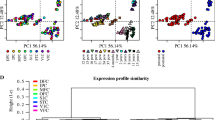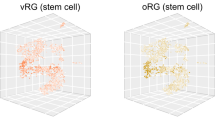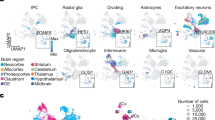Abstract
Brain function depends on the specialisation of brain areas. In the murine cerebral cortex, the development of these areas depends on the coordinated expression of several genes in precise spatial patterns in the telencephalon during embryogenesis. Manipulating the expression of these genes during development alters the positions and sizes of cortical areas in the adult. Qualitative data also show that these genes regulate each other’s expression during development so that they form a regulatory network with many feedback loops. However, it is currently unknown which regulatory interactions are critical to generating the correct expression patterns to lead to normal cortical development. Here, we formalise the relationships inferred from genetic manipulations into computational models. We simulate many different networks potentially consistent with the experimental data and show that a surprising diversity of networks produce similar results. This demonstrates that existing data cannot uniquely specify the network. We conclude by suggesting experiments necessary to constrain the model and help identify and understand the true structure of this regulatory network.







Similar content being viewed by others
References
Albert R, Othmer HG (2003) The topology of the regulatory interactions predicts the expression pattern of the segment polarity genes in Drosophila melanogaster. J Theor Biol 223:1–18
Allen developing mouse brain atlas (2009) [Internet]. Seattle (WA): Allen Institute for Brain Science. http://developingmouse.brain-map.org
Armentano M, Chou SJ, Tomassy GS, Leingärtner A, O’Leary DDM, Studer M (2007) COUP-TFI regulates the balance of cortical patterning between frontal/motor and sensory areas. Nat Neurosci 10:1277–1286
Bolouri H, Davidson EH (2002) Modeling transcriptional regulatory networks. Bioessays 24:1118–1129
Brandman O, Meyer T (2008) Feedback loops shape cellular signals in space and time. Science 322:390–395
Chaves M, Sengupta A, Sontag E (2008) Geometry and topology of parameter space: investigating measures of robustness in regulatory networks. J Math Biol 59:315–358
Cholfin JA, Rubenstein JLR (2008) Frontal cortex subdivision patterning is coordinately regulated by Fgf8, Fgf17, and Emx2. J Comp Neurol 509:144–155
Davidson EH (2010) Emerging properties of animal gene regulatory networks. Nature 468:911–920
Dayarian A, Chaves M, Sontag ED, Sengupta AM (2009) Shape, size, and robustness: feasible regions in the parameter space of biochemical networks. PLoS Comput Biol 5:e1000256
De Jong H (2002) Modeling and simulation of genetic regulatory systems: a literature review. J Comput Biol 9:67–103
Fagiolo G (2007) Clustering in complex directed networks. Phys Rev E Stat Nonlin Soft Matter Phys 76:026107
Fisher J, Henzinger TA (2007) Executable cell biology. Nat Biotechnol 25:1239–1249
Fukuchi-Shimogori T, Grove EA (2003) Emx2 patterns the neocortex by regulating FGF positional signaling. Nat Neurosci 6:825–831
Garel S, Huffman KJ, Rubenstein JLR (2003) Molecular regionalization of the neocortex is disrupted in Fgf8 hypomorphic mutants. Development 130:1903–1914
Giacomantonio CE, Goodhill GJ (2010) A Boolean model of the gene regulatory network underlying mammalian cortical area development. PLoS Comput Biol 6:e1000936
Glass L, Kauffman SA (1973) The logical analysis of continuous, non-linear biochemical control networks. J Theor Biol 39:103–129
Gleich D (2009) gaimc: graph algorithms in Matlab code. Accessed 12 Aug 2011. http://www.mathworks.com/matlabcentral/fileexchange/24134
Gorski JA, Talley T, Qiu M, Puelles L, Rubenstein JLR, Jones KR (2002) Cortical excitatory neurons and glia, but not GABAergic neurons, are produced in the Emx1-expressing lineage. J Neurosci 22:6309–6314
Grove EA, Fukuchi-Shimogori T (2003) Generating the cerebral cortical area map. Annu Rev Neurosci 26:355–380
Hamasaki T, Leingärtner A, Ringstedt T, O’Leary DDM (2004) EMX2 regulates sizes and positioning of the primary sensory and motor areas in neocortex by direct specification of cortical progenitors. Neuron 43:359–372
Hébert JM, Fishell G (2008) The genetics of early telencephalon patterning: some assembly required. Nat Rev Neurosci 9:678-685
Hébert JM, McConnell SK (2000) Targeting of cre to the Foxg1 (BF-1) locus mediates loxP recombination in the telencephalon and other developing head structures. Dev Biol 222:296–306
Holland J (1975) Adaptation in natural and artificial systems. University of Michigan Press, Ann Arbor, MI
Jaeger J, Reinitz J (2006) On the dynamic nature of positional information. Bioessays 28:1102–1111
Jaeger J, Surkova S, Blagov M, Janssens H, Kosman D, Kozlov KN, Vanario-Alonso CE, Samsonova M, Sharp DH, Reinitz J (2004) Dynamic control of positional information in the early Drosophila embryo. Nature 430:368–371
Job C, Tan SS (2003) Constructing the mammalian neocortex: the role of intrinsic factors. Dev Biol 257:221–232
Karbowski J, Ermentrout GB (2004) Model of the early development of thalamo-cortical connections and area patterning via signaling molecules. J Comput Neurosci 17:347–363
Kirkpatrick S, Gelatt CD, Vecchi MP (1983) Optimization by simulated annealing. Science 220:671–680
Kitano H (2002) Systems biology: a brief overview. Science 295:1662–1664
Laubenbacher R, Stigler B (2004) A computational algebra approach to the reverse engineering of gene regulatory networks. J Theor Biol 229:523–537
Mallamaci A (2011) Molecular bases of cortico-cerebral regionalization. Prog Brain Res 189:37–64
Mallamaci A, Stoykova A (2006) Gene networks controlling early cerebral cortex arealization. Eur J Neurosci 23:847–856
Meir E, Von Dassow G, Munro E, Odell GM (2002) Robustness, flexibility, and the role of lateral inhibition in the neurogenic network. Curr Biol 12:778–786
Meyers EN, Lewandoski M, Martin GR (1998) An Fgf8 mutant allelic series generated by Cre- and Flp-mediated recombination. Nat Genet 18:136–141
Muzio L, DiBenedetto B, Stoykova A, Boncinelli E, Gruss P, Mallamaci A (2002) Emx2 and Pax6 control regionalization of the pre-neuronogenic cortical primordium. Cereb Cortex 12:129–139
Nakajima A, Isshiki T, Kaneko K, Ishihara S (2010) Robustness under functional constraint: the genetic network for temporal expression in Drosophila neurogenesis. PLoS Comput Biol 6:e1000760
O’Leary DD (1989) Do cortical areas emerge from a protocortex? Trends Neurosci 12:400–406
O’Leary DD, Sahara S (2008) Genetic regulation of arealization of the neocortex. Curr Opin Neurobiol 18:90–100
O’Leary DDM, Chou SJ, Sahara S (2007) Area patterning of the mammalian cortex. Neuron 56:252–269
Pellegrini M, Mansouri A, Simeone A, Boncinelli E, Gruss P (1996) Dentate gyrus formation requires Emx2. Development 122:3893–3898
Rakic P (1988) Specification of cerebral cortical areas. Science 241:170–176
Rakic P, Ayoub AE, Breunig JJ, Dominguez MH (2009) Decision by division: making cortical maps. Trends Neurosci 5:291-301
Sahara S, Kawakami Y, Belmonte JCI, O’Leary DDM (2007) Sp8 exhibits reciprocal induction with Fgf8 but has an opposing effect on anterior-posterior cortical area patterning. Neural Dev 2:10
Sansom SN, Hébert JM, Thammongkol U, Smith J, Nisbet G, Surani MA, McConnell SK, Livesey FJ (2005) Genomic characterisation of a Fgf-regulated gradient-based neocortical protomap. Development 132:3947–3961
Schilstra MJ, Nehaniv CL (2008) Bio-logic: gene expression and the laws of combinatorial logic. Artif Life 14:121–133
Storm EE, Rubenstein JLR, Martin GR (2003) Dosage of Fgf8 determines whether cell survival is positively or negatively regulated in the developing forebrain. Proc Natl Acad Sci USA 100:1757–1762
Storm EE, Garel S, Borello U, Hebert JM, Martinez S, McConnell SK, Martin GR, Rubenstein JLR (2006) Dose-dependent functions of Fgf8 in regulating telencephalic patterning centers. Development 133:1831–1844
Sur M, Leamey CA (2001) Development and plasticity of cortical areas and networks. Nat Rev Neurosci 2:251–262
Sur M, Rubenstein JLR (2005) Patterning and plasticity of the cerebral cortex. Science 310:805–810
Sylvester JB, Rich CA, Loh YHE, van Staaden MJ, Fraser GJ, Streelman JT (2010) Brain diversity evolves via differences in patterning. Proc Natl Acad Sci USA 107:9718–9723
Thieffry D, Sanchez L (2003) Dynamical modelling of pattern formation during embryonic development. Curr Opin Genet Dev 13:326–330
Tomlin CJ, Axelrod JD (2007) Biology by numbers: mathematical modelling in developmental biology. Nat Rev Genet 8:331–340
Toyoda R, Assimacopoulos S, Wilcoxon J, Taylor A, Feldman P, Suzuki-Hirano A, Shimogori T, Grove EA (2010) FGF8 acts as a classic diffusible morphogen to pattern the neocortex. Development 137:3439–3448
Vanier MC, Bower JM (1999) A comparative survey of automated parameter-search methods for compartmental neural models. J Comput Neurosci 7:149–171
Von Dassow G, Meir E, Munro EM, Odell GM (2000) The segment polarity network is a robust developmental module. Nature 406:188–192
Wittmann DM, Blöchl F, Trümbach D, Wurst W, Prakash N, Theis FJ (2009a) Spatial analysis of expression patterns predicts genetic interactions at the mid-hindbrain boundary. PLoS Comput Biol 5:e1000569
Wittmann DM, Krumsiek J, Saez-Rodriguez J, Lauffenburger DA, Klamt S, Theis FJ (2009b) Transforming Boolean models to continuous models: methodology and application to T-cell receptor signaling. BMC Syst Biol 3:98
Wolpert L (1969) Positional information and the spatial pattern of cellular differentiation. J Theor Biol 25:1–47
Yeung MKS, Tegnér J, Collins JJ (2002) Reverse engineering gene networks using singular value decomposition and robust regression. Proc Natl Acad Sci USA 99:6163–6168
Zembrzycki A, Griesel G, Stoykova A, Mansouri A (2007) Genetic interplay between the transcription factors Sp8 and Emx2 in the patterning of the forebrain. Neural Dev 2:8
Acknowledgments
We thank Peter Dayan, Linda Richards, Guillermina López-Bendito, and the anonymous reviewers for their helpful feedback and comments on the manuscript. This work was supported by an Australian Postgraduate Award to CEG and the Human Frontier Science Program (Grant RPG0029/2008-C).
Author information
Authors and Affiliations
Corresponding author
Rights and permissions
About this article
Cite this article
Giacomantonio, C.E., Goodhill, G.J. A computational model of the effect of gene misexpression on the development of cortical areas. Biol Cybern 108, 203–221 (2014). https://doi.org/10.1007/s00422-014-0590-x
Received:
Accepted:
Published:
Issue Date:
DOI: https://doi.org/10.1007/s00422-014-0590-x




